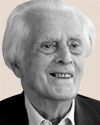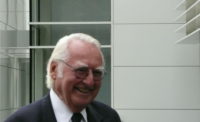Architect Frei Otto, a pioneer in lightweight tensile structures, died on March 9 at age 89, soon after he learned he had won the prestigious 2015 Pritzker Architecture Prize.
Otto, born in Siegmar, Germany, on May 31, 1925, was an "architect, visionary, utopian, ecologist, pioneer of lightweight materials, protector of natural resources and a generous collaborator with architects, engineers, biologists, among others," says the Pritzker Architecture Prize, in a release. Otto is the 40th laureate of the honor, sponsored by the Hyatt Foundation.
 |
| OTTO |
In engineering circles, Otto was best known for his innovative tensile structures, exemplified by the expansive tent covering the West Germany exhibit at Expo 67 in Montreal. "This 2-acre tent stands as the most advanced example of Otto's work in tensile structures. It portends an era when an envelope of cable mesh and plastic can be used to shelter whole cities and give them a controlled climate," said ENR in "Construction Spectacular Readies Montreal's 70-Nation World's Fair" (ENR 10/13/66 p. 90).
"The tent's seeming simplicity is deceptive. It is actually 'very audacious because of its lightness of construction,'" the article quoted Olgerd Tamowski, Otto's Canadian associate.
The audacity was achieved by a 1.5-psf structure all in tension, tuned with strain gauges, to give the building its integrity of shape and the ability, confirmed by wind tunnel tests, to resist 100-mph winds and heavy snow loads.
Five years later, Otto's series of cable-suspended roofs that linked three major stadiums stole the show at the 1972 Olympic games in Munich (ENR 9/23/71 p. 18). The 804,440-sq-ft lightweight structure of steel cable and acrylic panels, which weighed 1,810 tons, represented a further development of the prototype roof structure of the West German pavilion at Expo 67. Leonhardt & Andra provided engineering services.
The cost of the Munich roof, originally set at $4.2 million, ballooned to nearly $30 million. The roof was ground-assembled as a huge net of cables and lifted into place in four sections.
Another major project was the Japan Pavilion at Expo 2000 in Hanover, Germany, with architect and 2014 Pritzker Prize winner Shigeru Ban.
Lord Peter Palumbo, the chair of the jury for the prize, said in a statement about Otto: "His loss will be felt wherever the art of architecture is practiced the world over, for he was a universal citizen; whilst his influence will continue to gather momentum by those who are aware of it."






Post a comment to this article
Report Abusive Comment